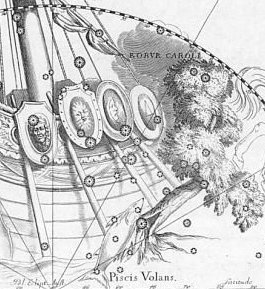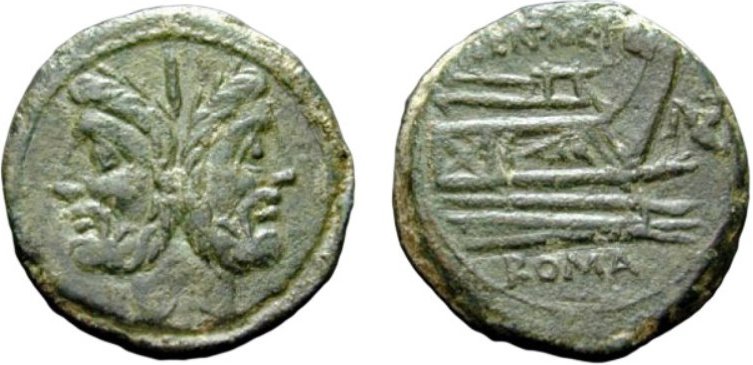There appears to have been a kind of physical barrier which disintegrated the fore part (the prow) of the Argo Ship.
Hevelius has a version which connects this place with the facts (fabrications) of English history: ... Robur Carolinum, Charles' Oak, the Quercia of Italy and the Karlseiche of Germany, was formally published by Halley in 1679 in commemoration of the Royal Oak of his patron, Charles II, in which the king had lain hidden for twenty-four hours after his defeat by Cromwell in the battle of Worcester, on the 3rd of September 1651 ...
Piscis Volans (the Flying Fish) could have been the idea behind the first dream-soul station on the mainland, viz. Pu Mahore: ... The dream soul of Hau Maka continued her journey and, thanks to her mana, reached another land. She descended on one of the small islets (off the coast). The dream soul of Hau Maka looked around and said: 'These are his three young men.' She named the three islets 'the handsome youths of Te Taanga, who are standing in the water.' The dream soul of Hau Maka continued her journey and went ashore on the (actual Easter) island. The dream soul saw the fish Mahore, who was in a (water) hole to spawn (?), [he ui te kuhane ko te mahore ka noho i roto i te pu.ka kake ro] and she named the place 'Pu Mahore A Hau Maka O Hiva.' The dream soul climbed up ... [E:6] Mahore. A fish (small, silver-coloured). Vanaga. Ta.: mahore, to peel off. Sa.: mafoe, to be skinned. Ma.: mahore, to be peeled. Churchill. Hore (Hore, horehore): to cut with a knife or with an obsidian blade (also: horea). Horeko, solitary, lonely; kona horeko, solitary place, loneliness. Vanaga. To hew, to cut off, to amputate, to castrate, to cut with a knife, to decapitate, to abridge, to incise, to set landmarks; a notch, incision, tenon; hore poto, to cut short off; hore te gao, to chop the head off. Churchill.
The great star at the hole in Robur Carolinum is β (Miaplacidus, *139).
Converting the date September 3 (246 = 2 * 123) to the Golden Age will demonstrate a correspondence with the beginning of the new year at JULY 1 (182 = 246 - 64): ... The month, which takes its name from Juppiter the oak-god, begins on June 10th and ends of July 7th. Midway comes St. John's Day, June 24th, the day on which the oak-king was sacrificially burned alive. The Celtic year was divided into two halves with the second half beginning in July, apparently after a seven-day wake, or funeral feast, in the oak-king's honour ...
It should not be necessary to adjust September 3 due to the precession since 1651 AD because the epoch should not be changed for such small precessional time distances.
The place of the Oak stood still. And since this Cosmic Tree stretched all the way from the bottom up to the top it makes sense to connect JULY with JANUARY (the month of the 2-faced Janus):
... In other words, the ancient Druidic religion based on the oak-cult will be swept away by Christianity and the door - the god Llyr - will languish forgotten in the Castle of Arianrhod, the Corona Borealis. This helps us to understand the relationship at Rome of Janus and the White Goddess Cardea who is ... the Goddess of Hinges who came to Rome from Alba Longa. She was the hinge on which the year swung - the ancient Latin, not the Etruscan year - and her importance as such is recorded in the Latin adjective cardinalis - as we say in English 'of cardinal importance - which was also applied to the four main winds; for winds were considered as under the sole direction of the Great Goddess until Classical times ...
And maybe the pair of faces (phases) was illustrated by a pair of mata:
Mata. 1. Tribe, people; te mata tûai-era-á, the ancient tribes. 2. Eye; mata ite, eyewitness. 3. Mesh: mata kupega. 4. Raw, uncooked, unripe, green, matamata, half-cooked, half-ripe. Kahi matamata, a tuna fish. Vanaga. 1. The eye; mata neranera, mata kevakeva, mata mamae, to be drowsy; mata keva, mataraparapa, matapo, blind; mata hakahira, squint eyed; mata pagaha, eye strain. 2. Face, expression, aspect, figure, mien, presence, visage, view; mata mine, mata hakataha, mata pupura, mata hakahiro, to consider. 3. Raw, green, unripe. 4. Drop of water. 5. Mesh; hakamata, to make a net. 6. Cutting, flint. 7. Point, spear, spike (a fish bone). 8. Chancre. Matamata, sound of water. Churchill. There is a wide range of significations in this stem. It will serve to express an opening as small as the mesh of a net or as large as a door of a house; it will serve to designate globular objects as large as the eye or as small as the bud on a twig or the drop of rain, and designating a pointed object it answers with equal facility for the sharpened tip of a lance or the acres of a headland; it describes as well the edge of a paddle or the source from which a thing originates. Churchill 2. Matá. Black obsidian spear points, all belonging to the Late Period which began ca 1680. Heyerdahl 3.
|
|||||||||||||||||||||||||||||||||||||||||||||||||||||||||||||||||||||||||||||||||||||||||||||||||||||||||||||||||||||||||||||||||||||||||||
.jpg)












